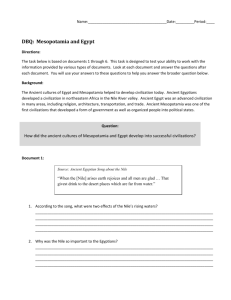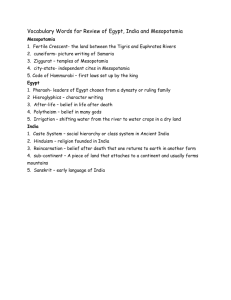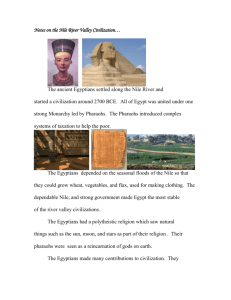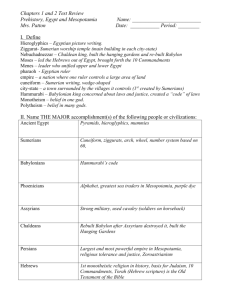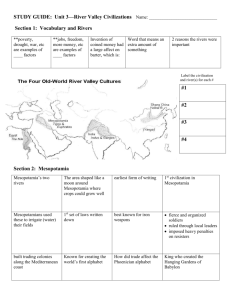Mesopotamia and Egypt DBQ
advertisement
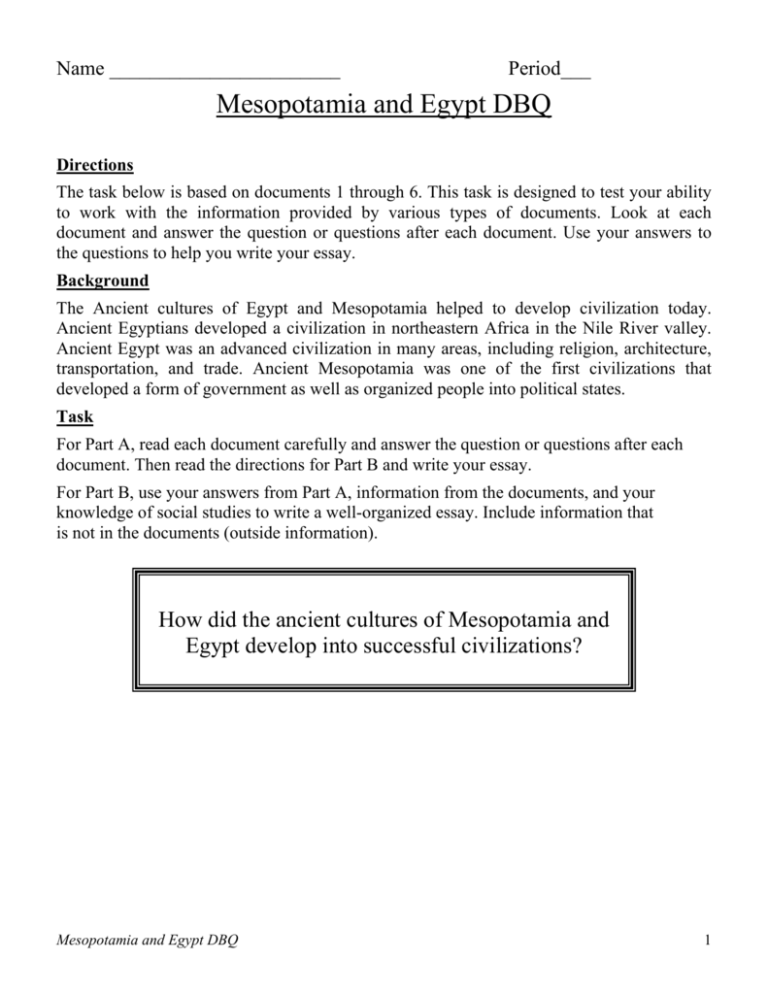
Name _______________________ 3HULRGBBB Mesopotamia and Egypt DBQ Directions The task below is based on documents 1 through 6. This task is designed to test your ability to work with the information provided by various types of documents. Look at each document and answer the question or questions after each document. Use your answers to the questions to help you write your essay. Background The Ancient cultures of Egypt and Mesopotamia helped to develop civilization today. Ancient Egyptians developed a civilization in northeastern Africa in the Nile River valley. Ancient Egypt was an advanced civilization in many areas, including religion, architecture, transportation, and trade. Ancient Mesopotamia was one of the first civilizations that developed a form of government as well as organized people into political states. Task For Part A, read each document carefully and answer the question or questions after each document. Then read the directions for Part B and write your essay. For Part B, use your answers from Part A, information from the documents, and your knowledge of social studies to write a well-organized essay. ,QFOXGHLQIRUPDWLRQWKDW LVQRWLQWKHGRFXPHQWV RXWVLGHLQIRUPDWLRQ How did the ancient cultures of Mesopotamia and Egypt develop into successful civilizations? Mesopotamia and Egypt DBQ 1 Document 1 Egyptian civilization began close to the Nile River because the Nile provided a fertile area in the middle of a desert. The people depended on the Nile for food and water. Heavy rains caused the Nile to overflow regularly, which made the soil fertile and good for farming. The ancient Egyptians sang this song about the benefits of the Nile: “When the [Nile] arises earth rejoices and all men are glad…. That givest drink to the desert places which are far from water.” 1. According to the song, what were two effects of the Nile’s rising waters? Tell them in your own words. __________________________________________________________________________ __________________________________________________________________________ __________________________________________________________________________ __________________________________________________________________________ 2. Why was the Nile so important to the Egyptians? __________________________________________________________________________ __________________________________________________________________________ __________________________________________________________________________ __________________________________________________________________________ __________________________________________________________________________ Mesopotamia and Egypt DBQ 2 Document 2 The Rivers were a vital part of the development of a civilization. They provided many resources which included food, transportation, as well as plants. Since the rivers were in the middle of deserts and was surrounded by rough terrain, the development of city-states was inevitable. Mesopotamia developed along the rivers named the Tigris and Euphrates Rivers. 1. The Tigris and Euphrates Rivers were so important to the survival of people. Why were they so important for the development of a civilization? __________________________________________________________________________ __________________________________________________________________________ __________________________________________________________________________ __________________________________________________________________________ 2. Based upon the map, what is surrounding the Fertile Crescent in the south and in the East? __________________________________________________________________________ __________________________________________________________________________ __________________________________________________________________________ __________________________________________________________________________ Mesopotamia and Egypt DBQ 3 Document 3 Ancient Egyptians referred to their king as a pharaoh. What follows is a description of the role of a pharaoh, found on a tomb: “[A pharaoh] is a god by whose dealings one lives, the father and mother of all... without an equal.” 1. Based on the quotation, what did ancient Egyptians believe made the pharaoh such a special person? ________________________________________________________________________ ________________________________________________________________________ ________________________________________________________________________ ________________________________________________________________________ ________________________________________________________________________ 2. What type of power did the pharaoh possess in Egypt? Define the term. ________________________________________________________________________ ________________________________________________________________________ ________________________________________________________________________ ________________________________________________________________________ ________________________________________________________________________ Mesopotamia and Egypt DBQ 4 DOCUMENT #4 In the Code of Hammurabi, the laws concerned daily life, business, medicine, property, and family. Punishment for breaking these laws was very harsh. For example, people caught stealing could be put to death. Those who did not show care and respect for the property of others had to pay a fine. Hammurabi stated his goal for the law code in this way: “...to render [give] good to the people, to make justice shine in the land, to destroy the evil and wicked, that the strong do not oppress [mistreat] the weak.” 1. Name three things Hammurabi wanted to accomplish with this set of laws. ________________________________________________________________________ ________________________________________________________________________ ________________________________________________________________________ ________________________________________________________________________ ________________________________________________________________________ 2. How were people punished for stealing in Hammurabi’s time? ________________________________________________________________________ ________________________________________________________________________ ________________________________________________________________________ ________________________________________________________________________ ________________________________________________________________________ Mesopotamia and Egypt DBQ 5 Document 5 Ancient Egyptian pharaohs, or god-kings, had workers build huge pyramids to serve as tombs. Egyptians believed that their kings could take their possessions with them after death. As a result, pharaohs were buried with their possessions. Below is a diagram of a pyramid. 1. Where was the king’s (pharaoh’s) chamber located? ________________________________________________________________________ ________________________________________________________________________ ________________________________________________________________________ ________________________________________________________________________ ________________________________________________________________________ 2. Why do you think a temple was included? ________________________________________________________________________ ________________________________________________________________________ ________________________________________________________________________ ________________________________________________________________________ ________________________________________________________________________ ________________________________________________________________________ Mesopotamia and Egypt DBQ 6 Document 6 Sumerians and Akkadians practiced polytheism, the worship of many gods. They believed that keeping the gods happy was the key to their own happiness and prosperity. On the other hand, if the gods were angry, they might bring suffering and disaster. Sumerians built huge temples called ziggurats. They believed these temples linked Earth with the heavens and linked people with the gods. 1. Look at the illustration. Notice the number of stairs. What does the size of the temple tell you about the value the Sumerians placed on their gods? ________________________________________________________________________ ________________________________________________________________________ ________________________________________________________________________ ________________________________________________________________________ ________________________________________________________________________ 2. From the passage, what did the Sumerians and Akkadians look to their gods for? ________________________________________________________________________ ________________________________________________________________________ ________________________________________________________________________ ________________________________________________________________________ ________________________________________________________________________ Mesopotamia and Egypt DBQ 7 Putting It All Together Directions Using the documents, your answers from Part A, and your knowledge of social studies, write a well-organized essay about the following: How did the ancient cultures of Mesopotamia and Egypt develop into successful civilizations? In your essay remember to: Include information about beliefs, way of life, and leadership. Describe the role of a pharaoh as well as priests of Mesopotamia. Include an introduction, a body, and a conclusion. Include details, examples, or reasons to develop your ideas. Use information from 5 documents in your answer. Helpful Hints Edit your work Use the documents to feed the essay; however do not forget outside information!! Mesopotamia and Egypt DBQ 8
